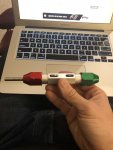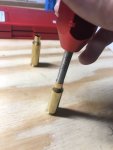Loading 6.5 CM with 140 Hornady.
FL Redding sizing die.
Then run the brass through a Sinclair Expander die.
Bullet seating with LE Wilson seating die and a KM arbor press.
Issue is that I am getting far too many pieces of brass that take way too much pressure to seat the bullet. I have some Hornady and Prime brass. All of it is 2x fired at most. Annealed prior to re-sizing.
Looking at the Brownells site (Sinclair) but I do not see any other options for a different size expander mandrel.
About to load some 300 WM and I am afraid of hitting the same issues.
Suggestions?
Thanks!
FL Redding sizing die.
Then run the brass through a Sinclair Expander die.
Bullet seating with LE Wilson seating die and a KM arbor press.
Issue is that I am getting far too many pieces of brass that take way too much pressure to seat the bullet. I have some Hornady and Prime brass. All of it is 2x fired at most. Annealed prior to re-sizing.
Looking at the Brownells site (Sinclair) but I do not see any other options for a different size expander mandrel.
About to load some 300 WM and I am afraid of hitting the same issues.
Suggestions?
Thanks!





